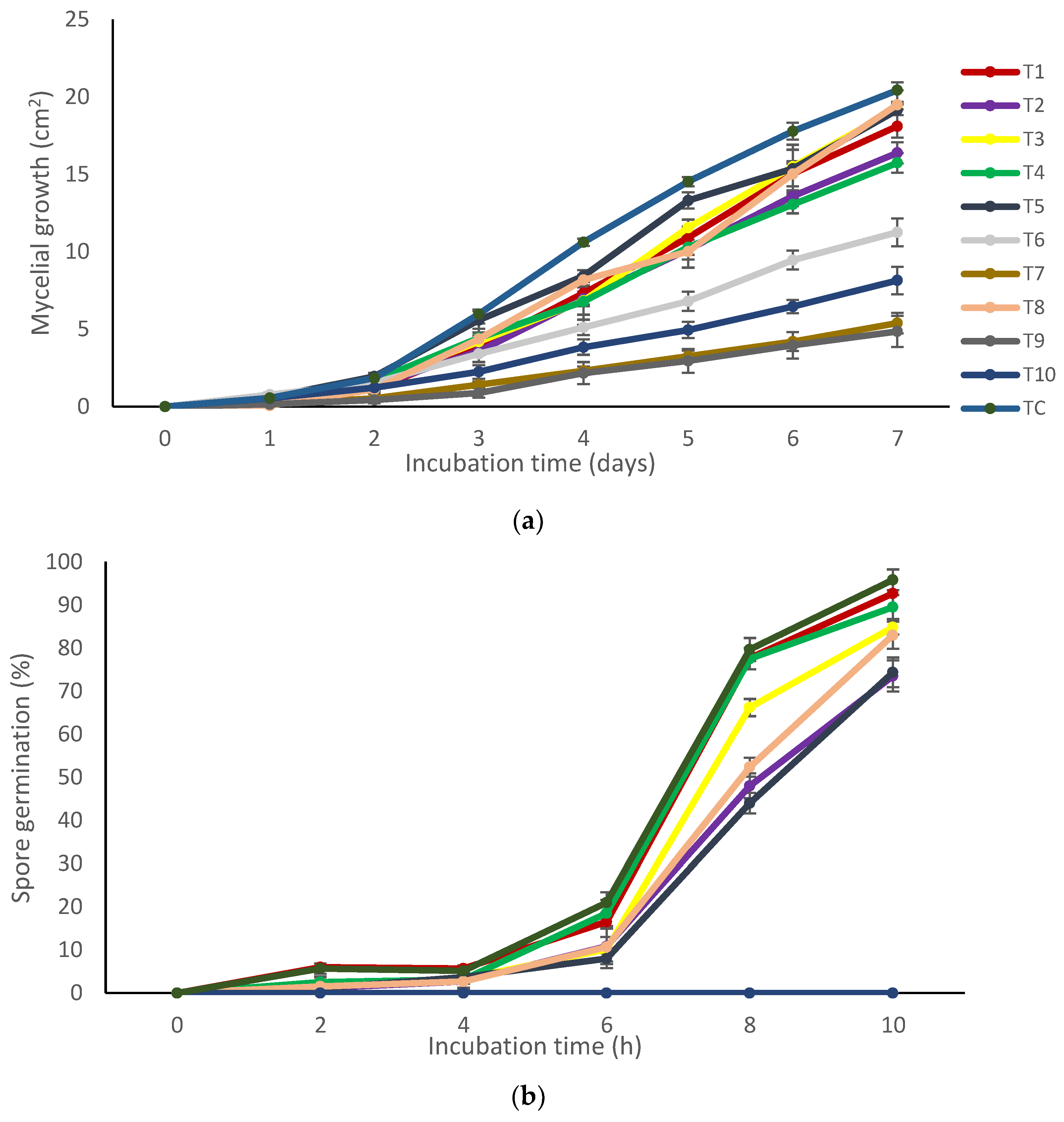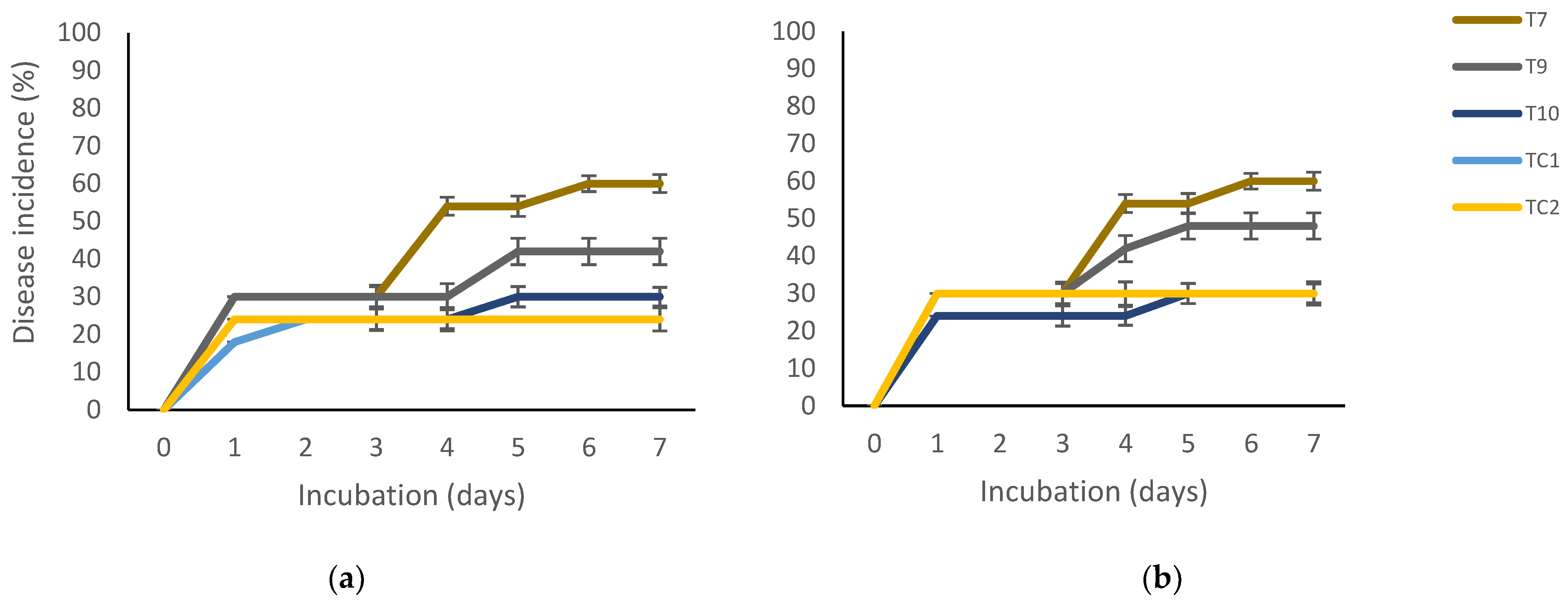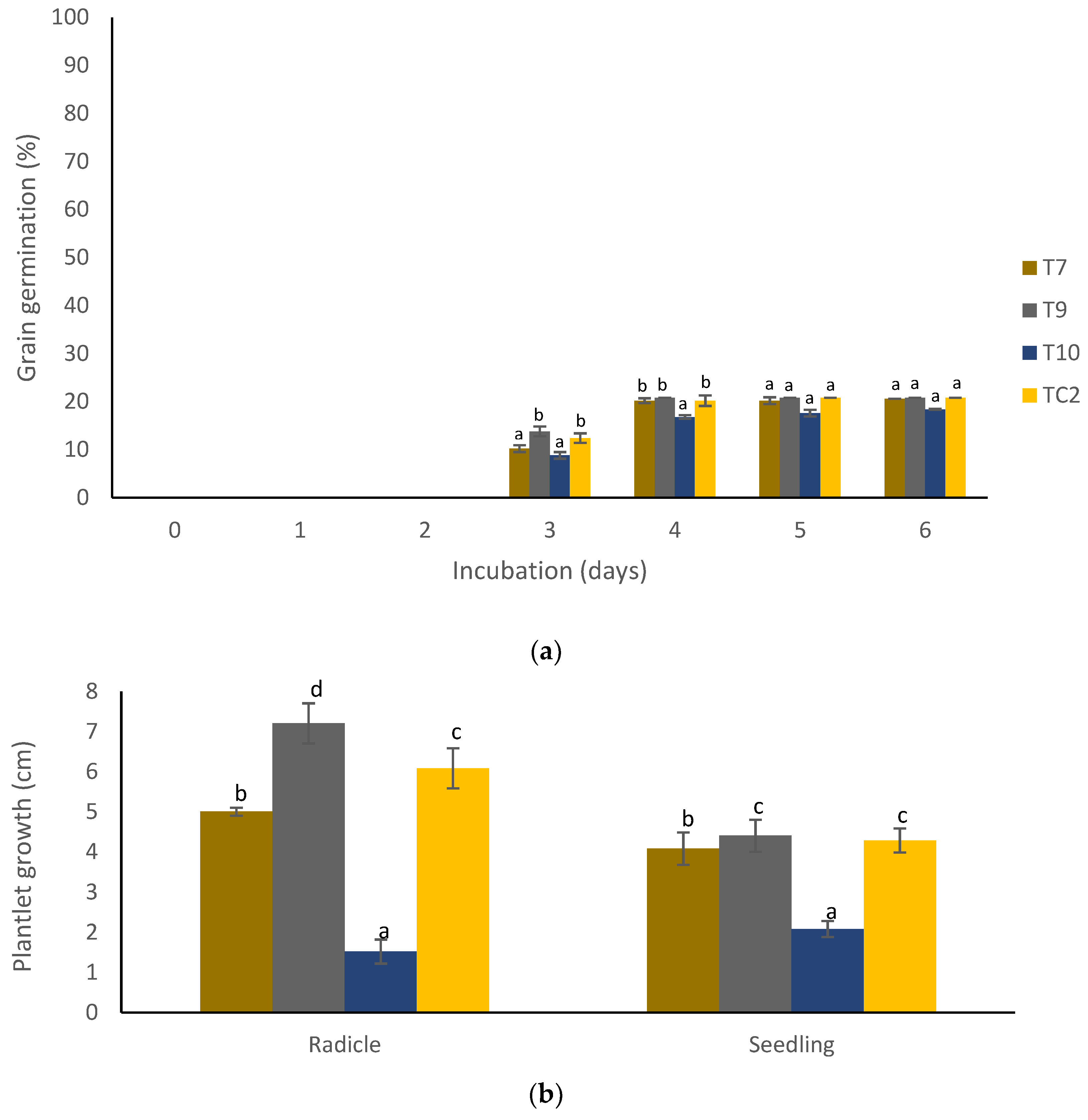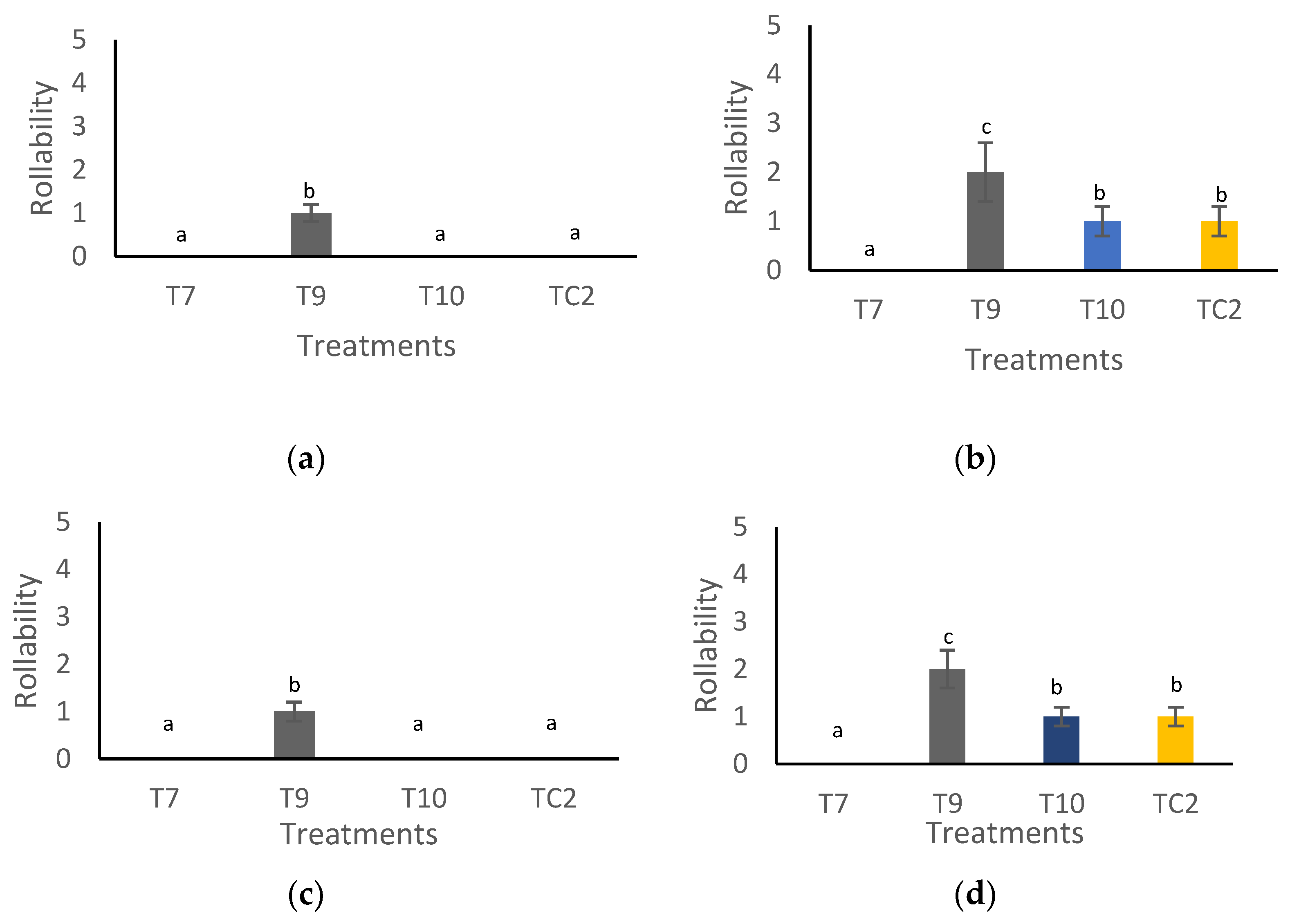Effect of Biodegradable Coatings on the Growth of Aspergillus flavus In Vitro, on Maize Grains, and on the Quality of Tortillas during Storage
Abstract
:1. Introduction
2. Results
2.1. Effect of Natural-Based Coatings on In Vitro A. flavus Development
2.2. Effect of Natural-Based Coatings on Grain Maize Disease Incidence, Germination, and Plant Growth
2.3. Effect of Natural-Based Coatings on the Quality of Tortilla Made with Coated Grains
3. Discussion
4. Materials and Methods
4.1. In Vitro Assays
Aspergillus flavus Strain
4.2. Formulations and Treatment Application
4.2.1. Preparation of Chitosan, Propolis, and Pine Resin Extract Solutions
4.2.2. Preparation of Nanoparticles of Chitosan, Propolis + Chitosan, and Pine Resin Extract + Chitosan
4.2.3. Formulations and Treatment Application for In Vitro Evaluations on A. flavus
4.3. In Vitro Assays
Mycelial Growth and Spore Germination
4.4. Assays on Maize Grains
Grain Maize Preparation, Formulations Applied, and Variables Evaluated
4.5. Assays on Tortilla
4.5.1. Formulations Applied on Maize Grains
4.5.2. Maize Grains Nixtamalization
4.5.3. Tortilla Elaboration
4.6. Evaluation of Quality Variables of Tortillas Made with Coated Maize Grains
4.6.1. Humidity
4.6.2. Weight Loss
4.6.3. Rollability
4.6.4. Color
4.7. Evaluation of the Presence of A. flavus Tortillas Made of Coated Maize Grains
4.7.1. Disease Incidence
4.7.2. Aflatoxin Production
4.8. Statistical Analysis
5. Conclusions
Author Contributions
Funding
Institutional Review Board Statement
Informed Consent Statement
Data Availability Statement
Conflicts of Interest
Sample Availability
References
- Barkai-Golan, R. Aspergillus Mycotoxins. In Mycotoxins in Fruits and Vegetables; Barkai-Golan, R., Paster, N., Eds.; Academic Press: Cambridge, MA, USA; Elsevier: Amsterdam, The Netherlands, 2008; pp. 115–151. [Google Scholar]
- Battilani, P.; Barbano, C.; Logrieco, A. Risk assessment and safety evaluations of mycotoxins in fruits. In Mycotoxins in Fruits and Vegetables; Barkai-Golan, R., Paster, N., Eds.; Academic Press: Cambridge, MA, USA; Elsevier: Amsterdam, The Netherlands, 2008; pp. 1–26. [Google Scholar]
- Martínez, P.H.Y.; Hernández, D.S.; Reyes, M.C.A.; Vázquez, C.G. El género Aspergillus y sus micotoxinas en maíz en México: Problemática y perspectivas. Rev. Mex. Fitopatol. 2013, 31, 126–146. Available online: https://www.researchgate.net/deref/http%3A%2F%2Fwww.redalyc.org%2Farticulo.oa%3Fid%3D61231509005 (accessed on 15 July 2022).
- Schaarschmidt, S.; Fauhl-Hassek, C. Mycotoxins during the processes of nixtamalization and tortilla production. Toxins 2019, 11, 227. [Google Scholar] [CrossRef] [Green Version]
- Méndez-Albores, J.A.; Arámbula-Villa, G.; Loarca-Piña, M.; González-Hernández, J.; Castaño-Tostado, E.; Moreno-Martínez, E. Aflatoxins’ fate during the nixtamalization of contaminated maize by two tortilla-making processes. J. Stored Prod. Res. 2004, 40, 87–94. [Google Scholar] [CrossRef]
- Anguiano-Ruvalcaba, G.L.; Verver, V.C.A.; Guzmán-de Peña, D. Inactivación de aflatoxina B1 y aflatoxicol por nixtamalización tradicional del maíz y su regeneración por acidificación de la masa. Salud Pública Méx. 2005, 47, 369–375. [Google Scholar] [CrossRef] [PubMed] [Green Version]
- Norma Oficial Mexicana NOM-247-SSA1-2008, productos y servicios. Cereales y sus productos. Productos de panificación. Disposiciones y especificaciones sanitarias y nutrimentales. Available online: http://dof.gob.mx/nota_detalle.php?codigo=5100356&fecha=27/07/2009 (accessed on 5 June 2022).
- Plascencia-Jatomea, M.; Yépiz-Gómez, M.S.; Velez-Haro, J.M. Aspergillus spp. (Black mold). In Postharvest Decay; Bautista-Baños, S., Ed.; Control Strategies; Academic Press: Mexico city, Mexico; Elsevier: Amsterdam, The Netherlands, 2014; pp. 267–286. [Google Scholar] [CrossRef]
- Moreno, M.E.; Vázquez, B.M.; Facio, P.F. Uso de sales del ácido propiónico para inhibir la producción de aflatoxinas en granos almacenados de maíz. Agrociencia 2000, 34, 477–484. [Google Scholar]
- Cantú-Almaguer, M.A.; Reyes-Méndez, C.A.; Rodríguez del Bosque, L.A. La Fecha de Siembra: Una alternativa para Incrementar la producción de maíz. Folleto técnico no. 44. Campo Experimental Río Bravo 2010, INIFAP-SAGARPA. Río Bravo, México. p. 40. Available online: https://www.compucampo.com/tecnicos/fechasiembra-maiz.pdf (accessed on 15 July 2022).
- Aliabadi, M.A.; Alikhani, F.E.; Mohammadi, M.; Darsanaki, R.K. Biological control of aflatoxins. Eur. J. Exp. Biol. 2013, 3, 162–166. Available online: https://www.primescholars.com/articles/biological-control-of-aflatoxins.pdf (accessed on 15 July 2022).
- Moreno-Limón, S.; González-Solís, L.; Salcedo-Martínez, S.M.; Cárdenas-Avila, M.L.; Perales-Ramírez, A. Efecto antifúngico de extractos de gobernadora (Larrea tridentata L.) sobre la inhibición in vitro de Aspergillus flavus y Penicillium sp. Polibotánica 2011, 32, 193–205. Available online: http://www.scielo.org.mx/scielo.php?script=sci_arttext&pid=S1405-27682011000200012 (accessed on 15 July 2022).
- El-Nagerabi, S.A.F.; Elshafie, A.E.; Alkhanjari, S.S.; Al-Bahry, S.; Elamin, M.R. Biological activities of Boswellia sacra extracts on the growth and aflatoxins secretion of two aflatoxigenic species of Aspergillus species. Food Control 2013, 34, 763–769. [Google Scholar] [CrossRef]
- El-Gamal, R.; Nikolaivits, E.; Zervakis, G.I.; Abdel-Maksoud, G.; Topakas, E.; Christakopoulos, P. The use of chitosan in protecting wooden artifacts from damage by mold fungi. Electron. J. Biotechnol. 2016, 24, 70–78. [Google Scholar] [CrossRef] [Green Version]
- Cortes-Higareda, M.; Ramos-García, M.L.; Correa-Pacheco, Z.; Del Rio, J.C.; Bautista-Baños, S. Nanostructured chitosan/propolis formulations: Characterization and effect on the growth of Aspergillus flavus and production of aflatoxins. Heliyon 2019, 5, e01776. [Google Scholar] [CrossRef] [Green Version]
- Rodríguez, P.B.; Canales, M.M.M.; Penieres, C.J.G.; Cruz, S.T.A. Composición química, propiedades antioxidantes y actividad antimicrobiana de propóleos mexicanos. Acta Univ. 2020, 30, 2435. Available online: http://www.scielo.org.mx/pdf/au/v30/2007-9621-au-30-e2435.pdf (accessed on 15 July 2022).
- Bautista-Baños, S.; Barrera-Necha, L.L.; Hernández-López, M.; Rodríguez-González, F. Morphological and ultrastructural modifications of chitosan-treated fungal phytopathogens. In Chitosan in the Preservation of Agricultural Commodities; Bautista-Baños, S., Romanazzi, G., Jiménez-Aparicio, A., Eds.; Academic Press: Cambridge, MA, USA; Elsevier: Amsterdam, The Netherlands, 2016; pp. 251–275. [Google Scholar] [CrossRef]
- Romanazzi, G.; Feliziani, E.; Bautista-Baños, S.; Sivakumar, D. Shelf life extension of fresh fruit and vegetables by chitosan. Crit. Rev. Food Sci. Nut. 2017, 57, 579–601. [Google Scholar] [CrossRef] [PubMed]
- Amri, I.; Gargouri, S.; Hamrouni, L.; Hanana, M.; Fezzani, T.; Jamoussi, B. Chemical composition, phytotoxic and antifungical activities of Pinus pinea essential oil. J. Pestic. Sci. 2012, 85, 199–207. [Google Scholar] [CrossRef]
- Segura-Palacios, M.A.; Correa-Pacheco, Z.N.; Corona-Rangel, M.L.; Martinez-Ramirez, O.C.; Salazar-Piña, D.A.; Ramos-García, M.d.L.; Bautista-Baños, S. Use of natural products on the control of Aspergillus flavus and production of aflatoxins in vitro and on tomato fruit. Plants 2021, 10, 2553. [Google Scholar] [CrossRef]
- Aparicio-García, P.F.; Ventura-Aguilar, R.I.; Río-García, J.C.; Hernández-López, M.; Guillén-Sánchez, D.; Salazar-Piña, D.A.; Ramos-García, M.d.L.; Bautista-Baños, S. Edible chitosan/propolis coatings and their effect on ripening, development of Aspergillus flavus, and sensory quality in fig fruit, during controlled storage. Plants 2021, 10, 112. [Google Scholar] [CrossRef]
- Correa-Pacheco, Z.; Barrera-Necha, L.L.; Ventura-Aguilar, R.I.; Hernández-López, M.; Corona-Rangel, M.L.; Bautista-Baños, S. Aplicación de la nanotecnología en la conservación de productos agrícolas, como línea de investigación en el CEPROBI-IPN. In Avances de Investigación en Nanociencias, Micro y Nanotecnologías; San Martin, E., Ed.; OmniaScience (Omnia Publisher SL), Terrassa: Barcelona, Spain, 2021; Volume 3, pp. 145–170. [Google Scholar]
- Sotelo-Boyás, M.E.; Bautista-Baños, S.; Correa-Pacheco, Z.N.; Jiménez-Aparicio, A.; Sivakumar, D. Biological activity of chitosan nanoparticles against pathogenic fungi and bacteria. In Chitosan in the Preservation of Agricultural Commodities; Bautista-Baños, S., Romanazzi, G., Jiménez-Aparicio, A., Eds.; Academic Press: Cambridge, MA, USA; Elsevier: Amsterdam, The Netherlands, 2016; pp. 339–349. [Google Scholar] [CrossRef]
- Bautista-Baños, S.; Correa-Pacheco, Z.N.; Ventura-Aguilar, R.I. The use of chitosan based nanoformulations for controlling fungi during storage of horticultural commodities. In Chitin and Chitosan: Properties and Applications; Ben van den Broek, L., Boeriu, C., Eds.; Wiley Ed.: New York, NY, USA, 2020; pp. 371–394. [Google Scholar] [CrossRef]
- Wrather, A.; Sweets, L.; Bailey, W.; Claxton, T.; Sexten, J.; Carlson, M. Aflatoxins in Corn. University of Missouri Extension 2010, G4155. 1-4. Available online: https://extension.missouri.edu/publications/g4155 (accessed on 15 July 2022).
- Correa-Pacheco, Z.N.; Bautista-Baños, S.; de Ramos-García, M.L.; del Martínez-González, M.C.; Hernández-Roman, J. Physicochemical characterization and antimicrobial activity of propolis-chitosan nanoparticles edible coatings. Prog. Org. Coat. 2019, 137, 105326. [Google Scholar] [CrossRef]
- Hernández-López, M.; Correa-Pacheco, Z.N.; Bautista-Baños, S.; Zavaleta-Avejar, L.; Benítez-Jiménez, J.J.; Sabino-Gutiérrez, M.A.; Ortega-Gudiño, P. Bio-based composite fibers from pine essential oil and PLA/PBAT polymer blend. Morphological, physicochemical, thermal and mechanical characterization. Mater. Chem. Phys. 2019, 234, 345–353. [Google Scholar] [CrossRef]
- Lin, D.; Xing, B. Phytotoxicity of nanoparticles: Inhibition of seed germination and root growth. Environ. Pollut. 2007, 150, 243–250. [Google Scholar] [CrossRef]
- Khan, M.R.; Adam, V.; Rizvi, T.F.; Zhang, B.; Ahamad, F.; Jośko, I.; Zhu, Y.M.; Yang, M.; Mao, C. Nanoparticle–plant interactions: Two-way traffic. Small 2019, 15, 1901794. Available online: https://pubmed.ncbi.nlm.nih.gov/31318142/ (accessed on 15 July 2022). [CrossRef]
- Sotelo-Boyás, M.E.; Correa-Pacheco, Z.; Corona–Rangel, M.L.; Villanueva-Arce, R.; Bautista-Baños, S. Cellular alterations in Pectobacterium carotovorum treated with nanostructured formulations during the incubation time. Arch. Microbiol. 2019, 201, 615–622. [Google Scholar] [CrossRef]
- Rodríguez-Martínez, N.A.; Salazar-García, M.G.; Ramírez-Wong, B.; Islas-Rubio, A.R.; Platt-Lucero, L.C.; Morales-Rosas, I.; Marquez-Melendez, R.; Martínez-Bustos, F. Effect of malting and nixtamalization processes on the physicochemical properties of instant extruded corn flour and tortilla quality. Plant Foods Hum. Nutr. 2015, 70, 275–280. Available online: https://www.researchgate.net/publication/278045376_Effect_of_Malting_and_Nixtamalization_Processes_on_the_Physicochemical_Properties_of_Instant_Extruded_Corn_Flour_and_Tortilla_Quality (accessed on 15 July 2022). [CrossRef] [PubMed]
- Correa-Pacheco, Z.N.; Bautista-Baños, S.; Valle-Marquina, M.A.; Hernandez-Lopez, M. The effect of nanostructured chitosan and chitosan-thyme essential oil coatings on Colletotrichum gloeosporioides growth in vitro and on cv Hass avocado and fruit quality. J. Phytopathol. 2017, 165, 297–305. [Google Scholar] [CrossRef]
- Hernández, L.G.; Aguilar, S.L.; Barrera-Necha, L.L. Toxicological genotoxicological evaluation of chitosan nanoparticles loaded with pinene in a murine model. Intl. J. Green Herb. Chem. 2021, 9, 437–448. Available online: https://pubmed.ncbi.nlm.nih.gov/33096179/ (accessed on 15 July 2022).
- Leung, D.W.M. Some studies on maize seed germination and aging. Seed Symp. 1991, 33–36. Available online: https://www.agronomysociety.org.nz/files/SP9_8._Maize_seed_germination_and_ageing.pdf (accessed on 15 July 2022).
- Arámbula-Villa, G.; Figueroa-Rivera, M.G.; Rendón-Villalobos, R.; Mendoza-Elos, M.; Figueroa-Cárdenas, J.D.; Castanedo-Pérez, R.; Rodríguez-González, F. Chemical acetylation of nixtamalized maize flour and structural, rheological and physicochemical properties of flour, dough and tortillas. J. Food Sci. Technol. 2018, 55, 1065–1073. [Google Scholar] [CrossRef] [PubMed]
- Burnett, H.L.; Hunter, B.B. Illustrated Genera of Imperfect Fungi; Burgess Publishing, Co.: Minneapolis, MN, USA, 1972; p. 241. [Google Scholar]







| Treatments | % Glycerol | % Chitosan | % Propolis | % Pine resin | % CNP | % PNP | % PRNP |
|---|---|---|---|---|---|---|---|
| T1 | 0.3 | 99.1 | 0.6 | - | - | - | - |
| T2 | 0.3 | 59.1 | 0.6 | - | - | 40 | - |
| T3 | 0.3 | 59.7 | - | - | - | 40 | - |
| T4 | 0.3 | 59.1 | 0.6 | - | 40 | - | - |
| T5 | 0.3 | 59.7 | - | - | 40 | - | - |
| T6 | 0.3 | 59.7 | - | - | - | - | 40 |
| T7 | 0.3 | 59.7 | - | - | - | - | 40.3 |
| T8 | 0.3 | 99.7 | - | - | - | - | - |
| T9 | 0.3 | 98.0 | 0.6 | 1.1 | - | - | - |
| T10 | 0.3 | 59.7 | - | - | - | 20 | 20 |
| TC | - | - | - | - | - | - | - |
| Treatments | Storage Temperature | ||||||
|---|---|---|---|---|---|---|---|
| Days Stored at 4 °C | Days Stored at 28 °C | ||||||
| 0 | 3 | 7 | 14 | 21 | 0 | 3 | |
| Disease Incidence (%) | |||||||
| T9 | 0 | 0 | 0 | 0 | 0 | 0 | 100 |
| T10 | 0 | 0 | 0 | 0 | 0 | 0 | 0 |
| TC1 | 0 | 0 | 20 | 50′ | 50 | 0 | 100 |
| TC2 | 0 | 0 | 0 | 15 | 33 | 0 | 100 |
| Treatments | Storage Temperature at 4 °C (Days) | |
|---|---|---|
| 0 | 21 | |
| Aflatoxins (ppb) | ||
| T9 | 1.3 a * | 1.8 ab |
| T10 | 0.9 a | 1.0 a |
| TC1 | 2.4 a | 3.2 b |
| TC2 | 1.5 a | 1.7 ab |
Publisher’s Note: MDPI stays neutral with regard to jurisdictional claims in published maps and institutional affiliations. |
© 2022 by the authors. Licensee MDPI, Basel, Switzerland. This article is an open access article distributed under the terms and conditions of the Creative Commons Attribution (CC BY) license (https://creativecommons.org/licenses/by/4.0/).
Share and Cite
Ventura-Aguilar, R.I.; Gónzalez-Andrade, C.; Hernández-López, M.; Correa-Pacheco, Z.N.; Teksür, P.K.; Ramos-García, M.d.L.; Bautista-Baños, S. Effect of Biodegradable Coatings on the Growth of Aspergillus flavus In Vitro, on Maize Grains, and on the Quality of Tortillas during Storage. Molecules 2022, 27, 4545. https://doi.org/10.3390/molecules27144545
Ventura-Aguilar RI, Gónzalez-Andrade C, Hernández-López M, Correa-Pacheco ZN, Teksür PK, Ramos-García MdL, Bautista-Baños S. Effect of Biodegradable Coatings on the Growth of Aspergillus flavus In Vitro, on Maize Grains, and on the Quality of Tortillas during Storage. Molecules. 2022; 27(14):4545. https://doi.org/10.3390/molecules27144545
Chicago/Turabian StyleVentura-Aguilar, Rosa I., César Gónzalez-Andrade, Mónica Hernández-López, Zormy N. Correa-Pacheco, Pervin K. Teksür, Margarita de L. Ramos-García, and Silvia Bautista-Baños. 2022. "Effect of Biodegradable Coatings on the Growth of Aspergillus flavus In Vitro, on Maize Grains, and on the Quality of Tortillas during Storage" Molecules 27, no. 14: 4545. https://doi.org/10.3390/molecules27144545
APA StyleVentura-Aguilar, R. I., Gónzalez-Andrade, C., Hernández-López, M., Correa-Pacheco, Z. N., Teksür, P. K., Ramos-García, M. d. L., & Bautista-Baños, S. (2022). Effect of Biodegradable Coatings on the Growth of Aspergillus flavus In Vitro, on Maize Grains, and on the Quality of Tortillas during Storage. Molecules, 27(14), 4545. https://doi.org/10.3390/molecules27144545







